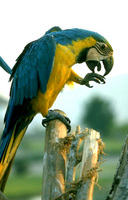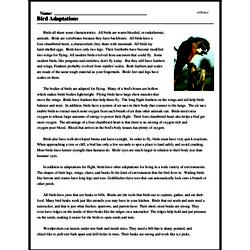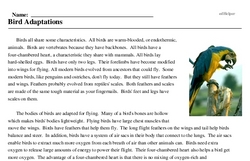Bird Adaptations
Birds all share some characteristics. All birds are warm-blooded, or endothermic, animals. Birds are vertebrates because they have backbones. All birds have a four-chambered heart, a characteristic they share with mammals. All birds lay hard-shelled eggs. Birds have only two legs. Their forelimbs have become modified into wings for flying. All modern birds evolved from ancestors that could fly. Some modern birds, like penguins and ostriches, don't fly today. But they still have feathers and wings. Feathers probably evolved from reptiles' scales. Both feathers and scales are made of the same tough material as your fingernails. Birds' feet and legs have scales on them.
The bodies of birds are adapted for flying. Many of a bird's bones are hollow which makes birds' bodies lightweight. Flying birds have large chest muscles that move the wings. Birds have feathers that help them fly. The long flight feathers on the wings and tail help birds balance and steer. In addition, birds have a system of air sacs in their body that connect to the lungs. The air sacs enable birds to extract much more oxygen from each breath of air than other animals can. Birds need extra oxygen to release large amounts of energy to power their flight. Their four-chambered heart also helps a bird get more oxygen. The advantage of a four-chambered heart is that there is no mixing of oxygen-rich and oxygen-poor blood. Blood that arrives in the bird's body tissues has plenty of oxygen.
Birds also have well-developed brains and keen eyesight. In order to fly, birds must have very quick reactions. When approaching a tree or cliff, a bird has only a few seconds to spot a place to land safely and avoid crashing. Most birds have keener eyesight than humans do. Birds' eyes are much larger in relation to their body size than humans' eyes.




